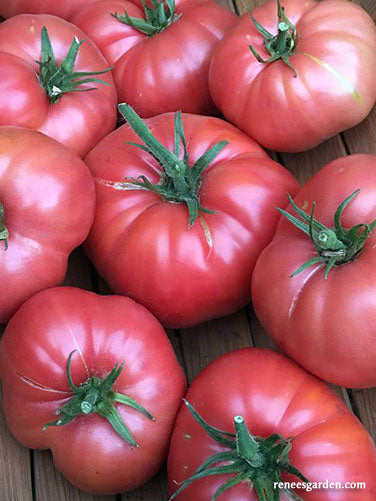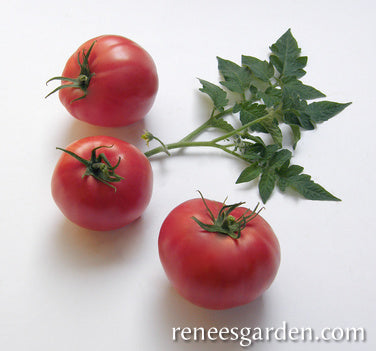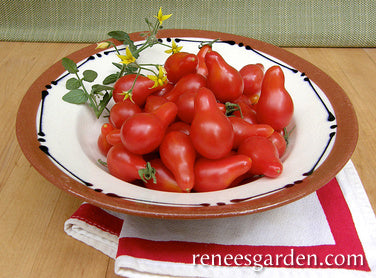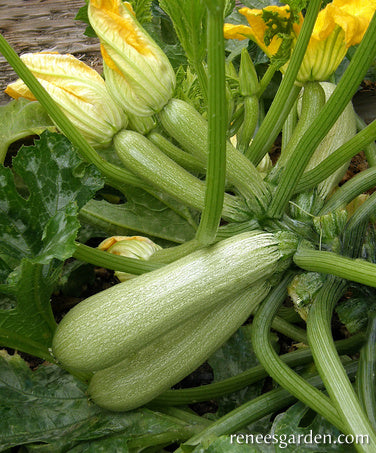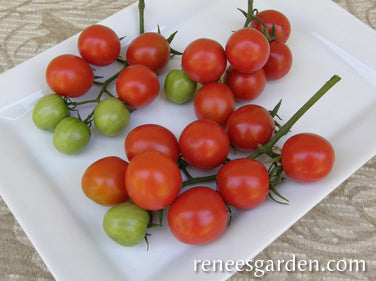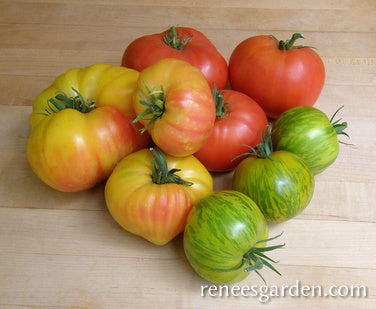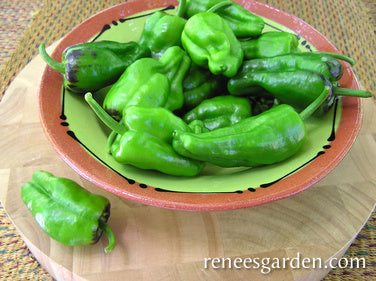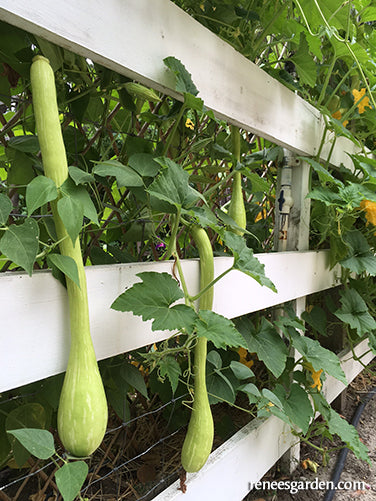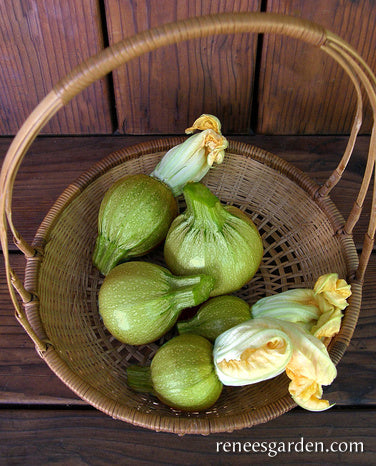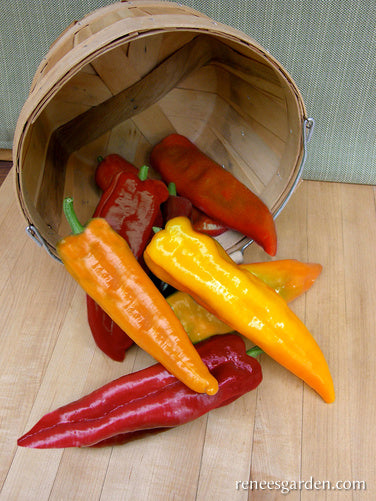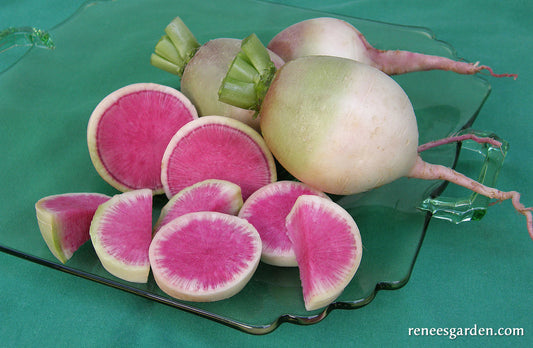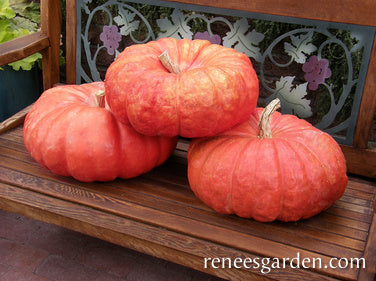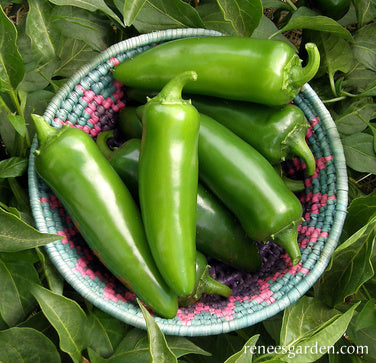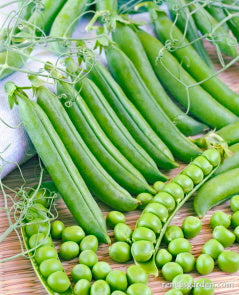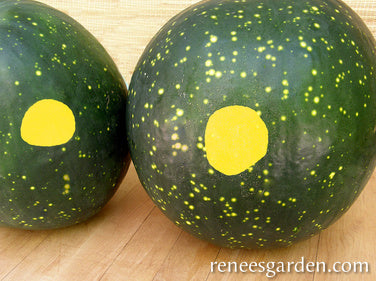Heirloom Selections
Old Varieties with Exceptional Beauty and Flavor
Our heirloom selections have been preserved and kept true to their beloved local history, often exhibiting unusual colors, shapes or flavors.
-
Heirloom Slicing Tomato Chianti Rose
STARTING SEEDLINGS
In early spring, start indoors about 6 to 8 weeks before outdoor night temperatures are reliably in the 50-55°F (10-13°C). Sow seeds 1/4 inch deep and 1 inch apart in a container of seed starting mix. Keep moist but not soggy, and very warm, 80°F (27°C). Provide a strong light source until seedlings are ready to plant outside. When 2 inches tall, transplant into individual 4-inch pots, burying stems up to base of leaves. Maintain at 70-75°F (21- 24°C). Feed with half-strength fertilizer every 2 weeks until ready to plant, then gradually acclimate seedlings to outdoor conditions. When nights reach 55°F (10°C), transplant 3 feet apart into rich soil in full sun.
GROWING NOTES
Prepare soil well with aged manure or compost. Plant several inches deeper than seedlings were growing in containers. Provide strong stakes or tall wire cages at planting time. Mulch to provide even moisture retention; don’t overwater once fruit begins to ripen.
HARVEST AND USE
For best flavor, pick fully ripe and don’t put these big beauties in the refrigerator! A real summer treat is a simple sandwich of thickly sliced Chianti Rose on good French bread layered with fresh basil leaves and a sprinkling of fruity olive oil. Or, stuff with seasoned rice, top with cheese and bake slowly to perfection.Regular price $3.69Sale price $3.69Unit price / per -
Heirloom Tomato Brandywine
STARTING SEEDLINGS
Start indoors about 6 to 8 weeks before outdoor night temperatures 50-55°F (10-13°C). Sow seeds 1/4 inch deep and 1 inch apart in a container of seed starting mix. Keep moist but not soggy, and very warm 80°F (24°C). Provide a strong light source until seedlings are ready to plant outside.
When seedlings are 2 inches tall, transplant into individual 4 inch pots, burying stems up to base of leaves. Maintain at 70°F (21°C). Feed with half-strength fertilizer every 2 weeks until nights reach 55°F (13°C), then gradually acclimate seedlings to outdoor conditions. Transplant these vigorous indeterminate climbers 3 feet apart into rich soil in full sun.
GROWING NOTES
Prepare soil well with aged manure or compost. Plant several inches deeper than seedlings were growing in containers. Provide strong stakes or tall wire cages at planting time. Mulch to provide even moisture retention; don't overwater once fruit begins to ripen.
HARVEST AND USE
For best flavor, pick fully ripe and don’t store in the refrigerator. These richly colored, juicy-sweet tomatoes are hard to resist straight out of the garden. Cut into thick slices and serve drizzled with olive oil and sprinkled with fresh chopped basil or dill for an irresistible summer treat.Regular price $4.89Sale price $4.89Unit price / per -
Heirloom Mini Tomatoes Red & Yellow Pear
STARTING SEEDLINGS
Start indoors about 8 weeks before outdoor night temperatures 50-55°F (10-13°C). Sow seeds 1/4 inch deep and 1 inch apart in a container of seed starting mix. Keep moist but not soggy, and very warm 75°F (24°C). Provide a strong light source until seedlings are ready to plant outside. When seedlings are 2 inches tall, transplant into individual containers, burying stems up to base of leaves. Maintain at 70°F (21°C). Feed with half-strength fertilizer every 2 weeks until weather is warm enough to gradually acclimate seedlings to outdoor conditions. Transplant these vigorous indeterminate climbers 3 feet apart into rich soil in full sun.
GROWING NOTES
Prepare soil well with aged manure or compost. Plant tomatoes several inches deeper than they were growing in containers. Provide strong stakes or tall wire cages at planting time as these plants grow tall with heavy fruit loads. Mulch to provide the even moisture tomato plants need to prevent cracking. Don’t overwater once fruit begins to ripen.
HARVEST AND USE
Pick the pear-shaped fruits when fully colored for best flavor. Enjoy for sweet snacks any time. Sprinkle liberally in salads where their pretty shapes and bright colors add wonderful eye and taste appeal.Regular price $2.99Sale price $2.99Unit price / per -
Heirloom Cherry Tomato Little Red Pear
STARTING SEEDLINGS
In early spring, start indoors about 6 to 8 weeks before outdoor night temperatures are reliably in the 50-55°F (10-13°C). Sow seeds 1/4 inch deep and 1 inch apart in a container of seed starting mix. Keep moist but not soggy, and very warm, 80°F (27°C). Provide a strong light source until seedlings are ready to plant outside. When seedlings are 2 inches tall, transplant into individual 4 inch pots. Maintain at 70°F (21°C). Feed with half-strength fertilizer every 2 weeks until ready to plant. When nights reach 55°F (13°C), gradually acclimate to outdoor conditions. Plant these vigorous indeterminate climbers 3 feet apart into rich soil in full sun.GROWING NOTES
Prepare soil well with compost and fertilizer. Plant tomatoes several inches deeper than they were growing in containers. Provide strong stakes or tall wire cages at planting time as these plants grow tall with heavy fruit loads. Mulch to provide the even moisture tomato plants need to prevent cracking. Don’t overwater once fruit begins to ripen.
HARVEST AND USE
Pick the pear-shaped fruits when fully colored for best flavor. Enjoy for sweet snacks any time. Sprinkle liberally in salads where their pretty shape and bright color add wonderful eye and taste appeal.Regular price $4.89Sale price $4.89Unit price / per -
Heirloom Italian Zucchini Ortolana di Faenza
START SEEDS OUTDOORS
Zucchinis need full sun, rich fertile soil and warm temperatures. Plant only when spring weather is warm and night temperatures stay above 50°F (10°C). Sow groups of 2 to 3 seeds,1 inch deep, every 2 feet, in rows 3 feet apart. Thin to leave only 1 seedling every 2 feet. Or, plant in slightly mounded hills, 2 feet in diameter, sowing 5 or 6 seeds in each hill. Thin hill-planted seedlings to 2 or 3 strongest plants.
GROWING NOTES
Amend soil well before sowing with lots of aged manure or compost. Protect young seedlings from marauding birds by covering with plastic berry baskets at planting time, removing when plants get crowded. Be sure to thin properly — you will have more productive, disease-free plants if seedlings have enough room to mature.
HARVEST AND USE
Harvest zucchini when no more than 5 to 6 inches long for best flavor. Frequent harvesting keeps plants producing tasty new fruits instead of maturing fat, tough, huge ones. Steam, stir-fry or grill sliced zucchinis and sprinkle with fresh parsley, dill, basil or thyme. Try the tasty blossoms sautéed or stuffed and baked. Heap a platter with spears of baby zucchinis to serve with your favorite dip for appetizers or snacks.Regular price $4.89Sale price $4.89Unit price / per -
Heirloom Tomatoes Camp Joy Cherry
STARTING SEEDLINGS
Start indoors about 8 weeks before outdoor night temperatures are reliably in the 55° (13°C) range. Sow seeds 1/4 inch deep and 1 inch apart in a container of seed starting mix. Keep moist but not soggy and very warm, 75°F (24°C). Provide a strong light source until seedlings are ready to plant outside. When they are 2 inches tall, transplant into 4 inch pots, burying stems up to base of leaves. Maintain around 70°F (21°C). Feed with half-strength fertilizer every 2 weeks until weather is warm enough to gradually acclimate seedlings to outdoor conditions. Transplant these vigorous indeterminate climbers 3 feet apart into rich soil in full sun.
HARVEST AND USE
Pick fruits when fully colored for best flavor. Enjoy for sweet snacks right out of the garden, in salads or stuffed with herbed cream cheese. For a delicious side dish, briefly sauté Camp Joy Cherries in a garlicky olive oil, then sprinkle with chopped fresh chives and basil.
GROWING NOTES
Prepare soil well with aged manure or compost. Plant tomatoes several inches deeper than they were growing in pots. Provide strong stakes or tall wire cages at planting time as plants grow tall with heavy fruit loads. Mulch to provide the even moisture that prevents cracking. Don’t overwater once fruit begins to ripen.
Regular price $3.39Sale price $3.39Unit price / per -
Heirloom Tomato Black Cherry
STARTING SEEDLINGS
Start indoors about 6 to 8 weeks before outdoor night temps are reliably in the 55°F(13°C) range. Sow seeds 1/4 inch deep and 1 inch apart in a container of seed starting mix. Keep moist but not soggy, and very warm, 80°F (27°C). Provide a strong light source until seedlings are ready to plant outside. When they are 2 inches tall, transplant into 4 inch pots, burying stems up to base of leaves. Maintain around 70°F (21°C). Feed with half-strength fertilizer every 2 weeks until weather is warm enough to gradually acclimate seedlings to outdoor conditions. Transplant these vigorous indeterminate climbers 3 feet apart into rich soil in full sun.
HARVEST AND USE
Pick fruits when fully ripe and colored-up for best flavor. Enjoy for sweet snacks right out of the garden, in salads or stuffed with herbed cream cheese. For a delicious side dish, briefly sauté in a garlicky olive oil, then sprinkle with chopped fresh chives and basil.
GROWING NOTES
Prepare soil well with aged manure or compost. Plant tomatoes several inches deeper than they were growing in pots. Provide strong stakes or tall wire cages at planting time as plants grow tall with heavy fruit loads. Mulch to provide the even moisture that prevents cracking. Don’t overwater once fruit begins to ripen.
Regular price $4.89Sale price $4.89Unit price / per -
Heirloom Tomato Black Krim
STARTING SEEDLINGS
In early spring, start indoors about 6 to 8 weeks before outdoor night temperatures are reliably in the 50-55°F (10-13°C). Sow seeds 1/4 inch deep and 1 inch apart in a container of seed starting mix. Keep moist but not soggy, and very warm, 80°F(27°C). Provide a strong light source until seedlings are ready to plant outside. When seedlings are 2 inches tall, transplant into individual 4 inch pots. Maintain at 70°F (21°C). Feed with half-strength fertilizer every 2 weeks until ready to plant. When nights reach 55°F (13°C), gradually acclimate to outdoor conditions. Plant these vigorous indeterminate climbers 3 feet apart into rich soil in full sun.
GROWING NOTES
Prepare soil well with aged manure or compost. Plant several inches deeper than seedlings were growing in containers. Provide strong stakes or tall wire cages at planting time. Mulch to provide even moisture retention; don't overwater once fruit begins to ripen.
HARVEST AND USE
For best flavor, pick fully ripe and don’t store in the refrigerator. These richly colored, meltingly tender tomatoes are hard to resist straight out of the garden. Cut into thick slices and serve with a little feta or goat cheese and chopped fresh dill or basil, then drizzle with olive oil for an irresistible summer treat.Regular price $4.89Sale price $4.89Unit price / per -
Heirloom Tomatoes Rainbow’s End
STARTING SEEDLINGS
In early spring, start indoors about 6 to 8 weeks before outdoor night temperatures are reliably in the 50-55°F (10-13°C) range. Sow seeds 1/4 inch deep and 1 inch apart in a container of seed starting mix. Keep moist but not soggy, and very warm, 80°F (27°C). Provide a strong light source until seedlings are ready to plant outside. When seedlings are 2 inches tall, transplant into individual 4 inch pots. Maintain at 70°F (21°C). Feed with half-strength fertilizer every 2 weeks until ready to plant. When nights reach 55°F (13°C), gradually acclimate to outdoor conditions. Plant these vigorous indeterminate climbers 3 feet apart into rich soil in full sun.
GROWING NOTES
Prepare soil well with aged manure or compost. Plant several inches deeper than seedlings were growing in containers. Provide strong stakes or tall wire cages at planting time. Mulch to provide even moisture retention; don’t overwater once fruit begins to ripen.
HARVEST AND USE
Pick these luscious old fashioned tomatoes fully ripe and eat promptly as they don’t hold well after harvest. Show off their flavors and gorgeous colors by slicing all three onto a big platter to surround with sprigs of fresh basil and top with a sprinkle of fruity olive oil.Regular price $3.99Sale price $3.99Unit price / per -
Tapas Peppers Spanish Padron
STARTING & GROWING
In early spring, start indoors 8 to 10 weeks before outdoor night temperatures are in the 55°F (13°C) range. Sow seeds 1/4 inch deep and 1 inch apart in a container of seed starting mix. Keep moist but not soggy, and very warm 75°F (24°C). Provide a strong light source until seedlings are ready to plant outside. When seedlings are 2 to 3 inches tall, transplant 3 inches apart into deeper containers. Maintain at 70°F (21°C). Feed with half-strength liquid fertilizer every 2 weeks. When weather is 55°F (13°C) both day and night, gradually acclimate seedlings to outdoor conditions. Transplant 1 1/2 feet apart into rich soil in full sun. Peppers need full sun at least 6 hours per day. Prepare soil well with aged manure or compost. Plant only robust seedlings with well-developed roots and mulch well to maintain even soil moisture. Water regularly and consistently and fertilize several times a month.
HARVESTING & PREPARING
For traditional Tapas, harvest the abundant little pointed fruits at no more than 2 inches long. At this small size, they are fragrant and flavorful; larger fruits get very spicy. To serve: Sauté the Tapas peppers quickly in a little hot olive oil just until the skins are glossy and slightly charred. To finish, sprinkle with coarse salt and enjoy while still hot. Most Padrons are mild, but occasionally one little pepper will have more spice — this is traditional and even sought after in Spain.Regular price $3.69Sale price $3.69Unit price / per -
Mexican Tomatillos Two Color Fiesta
BEST TO START INDOORS
In early spring, start indoors about 6 weeks before outdoor night temperatures are reliably in the 50-55°F (10-13°C) range. Sow seeds 1/4 inch deep and 1 inch apart in containers of seed starting mix. Keep moist but not soggy and very warm 75-80°F (24-27°C). Provide a strong light source until seedlings are ready to plant outside. When seedlings are 2 inches tall, transplant into 4 inch individual pots. Maintain at 70-75°F (21- 24°C). Feed with half-strength fertilizer every 2 weeks until weather is warm enough to gradually acclimate seedlings to outdoor conditions. Transplant 3 feet apart into rich soil in full sun once nights stay securely above 55°F (13°C).
GROWING NOTES
Prepare soil well with aged manure or compost. Provide strong stakes or wire cages at planting time, or tomatillos can spread over the ground if you have lots of space; they are vining plants similar to tomato vines. Mulch well to keep fruit clean and conserve moisture; don't overwater once fruits begin to ripen.
HARVEST AND USE
At first, tomatillo fruits look like little green balloons. As the fruit inside sizes up, they resemble cherry tomatoes surrounded by a papery husk. Pick when plump fruits fill out the husks and begin to break open, usually at 1 to 1 1/2 inches, but before fruits begin to turn yellow or soften.
Regular price $3.39Sale price $3.39Unit price / per -
Heirloom Climbing Summer Squash Trombetta di Albenga
START SEEDS OUTDOORS
Squash needs full sun, rich fertile soil and warm temperatures. Plant only when spring weather is warm and settled and night temperatures stay above 55°F (13°C). Train vigorous Trombetta vines up 6 to 8 foot stakes or a fence or trellis where they will make a lush leafy arbor or canopy and save garden space. Plant in full sun, sowing groups of 2-3 seeds 1 inch deep and 4 inches from vertical supports. Thin to the strongest seedling for each pole or to 12 inches apart along a fence.
GROWING NOTES
Amend soil well before sowing with lots of aged manure or compost. Protect young seedlings from marauding birds by covering with plastic berry baskets at planting time, removing when plants get crowded. Thin properly to get best quality fruits and highest yield. As young plants grow, tie them to supports.
HARVEST AND USE
Softly curved, lime-green Trombetta squashes are best harvested no longer than 10 to 12 inches long and as thick around as cucumbers. Sauté or stuff them, or use in any of your favorite summer squash recipes. Cook until just tender to enjoy their fine flavor and texture.Regular price $3.69Sale price $3.69Unit price / per -
Heirloom French Zucchini Ronde de Nice
START SEEDS OUTDOORS
Zucchinis need full sun, rich fertile soil and warm temperatures. Plant only when spring weather is warm and settled and night temperatures stay above 50°F (10°C). Sow groups of 2 to 3 seeds 1 inch deep and 2 feet apart. When seedlings have 4 leaves, thin to 1 strong seedling per group. Or, plant in slightly mounded hills, 2 feet in diameter, sowing 4 or 5 seeds in each hill. Thin hill-planted seedlings to the 2 or 3 strongest plants.
GROWING NOTES
Amend soil well before sowing with lots of aged manure or compost. Protect young seedlings from marauding birds by covering with plastic berry baskets at planting time, removing when plants get crowded. Be sure to thin properly – you will have more productive, disease-free plants if seedlings have enough room to mature.
HARVEST AND USE
Harvest Ronde de Nice as delicate babies when they reach just 1 or 2 inches in diameter or let grow to no more than 4 to 5 inches to enjoy best flavor and texture. Cook the little globes until just tender in a little butter and chicken broth and add your favorite chopped fresh herbs. Hollow out bigger squashes and chop up flesh, then combine with your favorite stuffing ingredients, fill the shells and bake to savory perfection.Regular price $4.89Sale price $4.89Unit price / per -
Heirloom French Pumpkins Cinderella's Carriage
BEST TO START OUTDOORS
Pumpkins need full sun, rich fertile soil and warm temperatures. Plant only when night temperatures are above 50°F (10°C). Sow groups of 3 seeds 3 feet apart and 1 inch deep in rows 4 feet apart. Thin to 1 strong seedling per group. Or, make circular soil mounds 3 feet across. Plant 6 seeds, 6 inches apart in center of each mound. Thin to the strongest 3 seedlings in each mound, so vigorous vines have room to grow and fruit.
GROWING NOTES
Plant pumpkins where the vigorous vines can sprawl. Protect young seedlings from marauding birds by covering with berry baskets at sowing time, removing before plants get crowded. Give vines ample water and feed several times for best yields.
HARVEST AND USE
These big plump beauties need to mature properly before harvest. Wait to pick until their rinds are fully deep orange and tough enough to resist piercing with a fingernail. Cut from vines, leaving good stem handles. Let cure in the sun for 10 days then store in a cool dry place and they’ll keep for months. Steam or bake the rich orange flesh for baked goods, soups or casseroles. Or hollow out the inside and use the ornamental pumpkin whole as a show-stopping serving dish for soup or stew.Regular price $4.39Sale price $4.39Unit price / per -
Heirloom Italian Sweet Peppers Sunset Mix
STARTING SEEDLINGS
In early spring, start indoors about 2 months before night temperatures stay above 50-55°F (10-13°C). Sow seeds ¼ inch deep and 1 inch apart in a container of seed starting mix. Keep moist but not soggy, and very warm 80-85°F (27-29°C). Provide a strong light source until seedlings are ready to plant outside. When 2 inches tall, transplant into individual 4 inch pots. Maintain at 70-75°F (21-24°C). Feed with half-strength fertilizer every week until weather is warm enough to gradually acclimate seedlings to outdoor conditions. Transplant 2 feet apart into rich soil in full sun.
GROWING NOTES
Don’t transplant outdoors until nights are above 50°F (10°C). Prepare soil well with aged manure or compost. Plant only robust seedlings with well-developed roots. Mulch plants to maintain even soil moisture.
GROWING & HARVEST
Peppers need full sun at least 6 hours per day. Mulch well to maintain even moisture. Fertilize weekly to establish vigorous plants that provide shade and protect fruit from sunburn. Stake or cage plants to keep fruit-laden branches from breaking.
Harvest when fruits are glossy and fully colored up red, orange or gold by cutting, not pulling from plants. Eat fresh, roast or grill or try them Italian style, sautéed with tomatoes, olive oil, garlic and basil, accompanied by good hard cheese and crusty bread.
Regular price $4.89Sale price $4.89Unit price / per -
Heirloom Radishes Watermelon
START SEEDS DIRECTLY OUTDOORS
Plant watermelon radishes at midsummer for fall harvest only. They size up and get sweeter as temperatures drop at the end of the growing season. Sow seeds in well-worked, fertile soil in full sun. Space seeds 1 inch apart, in rows 6 inches apart. Cover 1/2 inch deep. Keep soil evenly moist and well weeded. If the first sowing comes up unevenly, replant right away.
GROWING NOTES
Thin seedlings early to stand 3 inches apart; Watermelon radishes get big, up to three or even four inches in diameter and need room to size up. These Asian-style radishes grow more slowly than spring radishes, so be sure they have consistent moisture for best quality and flavor. Protect with a barrier of floating row cover if marauding birds or insect pests are a problem.
HARVEST AND USE
For best quality, harvest watermelon radishes promptly when sized up 2 to 4 inches in diameter. Note: Interior flesh becomes rosy red when roots are fully mature. Their flavor will be milder and sweeter harvested in cool fall weather. These roots will keep their eating quality for weeks in your refrigerator. For a beautiful and colorful salad, make a plate of very thinly sliced watermelon radishes sprinkled with oil and rice wine vinegar or fresh lemon juice and chopped scallions.Regular price $3.99Sale price $3.99Unit price / per -
Heirloom Radishes Pink Beauty
START SEEDS OUTDOORS
In early spring as soon as ground can be worked, sow radish seeds in well-worked, fertile soil in full sun. Space seeds 1 inch apart in rows 6 inches apart. Cover 1/2 inch deep. Keep soil evenly moist and well weeded. If first sowing comes up unevenly, replant right away. Sow again in late summer for a fall crop.
GROWING NOTES
Sow this quick growing, cool season crop wherever you intend to plant heat lovers later. Radishes thrive and have crisp flesh with the best mild flavor given consistent moisture. Sow small amounts a week apart to mature in warm but not hot weather. Thin quick-growing seedlings early to 2 inches apart so roots have room to size up. Protect radishes with floating row covers if marauding birds or flea beetles that chew holes in the leaves are a problem.
HARVEST AND USE
Harvest radishes when roots are the size of large marbles. If weather turns unexpectedly hot, pull, cut off tops, and store in the refrigerator for up to 3 weeks. Radishes will be spicier in hot weather and milder grown in cooler conditions. Combine sliced radishes, scallions and fresh dill or parsley for a great salad. Make delicious open faced sandwiches on whole grain bread spread with sweet butter and topped with sliced radishes.Regular price $4.89Sale price $4.89Unit price / per -
Heirloom Pumpkins Rouge Vif d'Etampes
BEST TO START OUTDOORS
Pumpkins need full sun, rich fertile soil and warm temperatures. Plant only when weather is warm and night temperatures stay above 50°F (10°C). Sow groups of 3 seeds 3 feet apart and 1 inch deep in rows 4 feet apart. Thin to 1 strong seedling per group. Or, make circular soil mounds 3 feet across. Plant 6 seeds, 6 inches apart in center of each mound. Thin to the strongest 3 seedlings in each mound, so vigorous vines have room to grow and fruit.
GROWING NOTES
Plant pumpkins where the vigorous vines can sprawl. Protect young seedlings from marauding birds by covering with berry baskets at sowing time, removing before plants get crowded. Give vines ample water and feed several times for best yields.
HARVEST AND USE
These big plump beauties need to mature properly before harvest. Wait to pick until their rinds are fully deep orange and tough enough to resist piercing with a fingernail. Cut from vines, leaving good stem handles. Let cure in the sun for 10 days then store in a cool dry place and they’ll keep for months. Steam or bake the rich orange flesh for baked goods, soups or casseroles. Or hollow out the inside and use the ornamental pumpkin whole as a show-stopping serving dish for soup or stew.Regular price $4.89Sale price $4.89Unit price / per -
Heirloom Chile Peppers Classic Jalapeño
STARTING SEEDLINGS
In early spring, start indoors about 2 months before night temperatures stay reliably 50-55°F (10-13°C). Sow seeds 1/4 inch deep and 1 inch apart in a container of seed starting mix. Keep moist but not soggy, and very warm 80-85°F (27-30°C). Provide a strong light source until seedlings are ready to plant outside. When seedlings are 2 inches tall, transplant into deeper individual containers. Maintain at 70-75°F (21-24°C). Feed with half-strength fertilizer every week until weather is warm enough to gradually acclimate seedlings to outdoor conditions. Transplant 2 feet apart into rich soil in full sun.
GROWING NOTES
Jalapeños need warm conditions. Don’t transplant outdoors until night temperatures stay securely above 55°F (13°C). Prepare soil well with aged manure or compost. Plant only robust seedlings with well-developed roots. Mulch plants to maintain even soil moisture. Keep well weeded, watered and fertilized.
HARVEST AND USE
To harvest, cut rather than pull fruits from the plants when deep glossy green or fully colored to red. Enjoy Jalapeños fresh or roast and remove skins. Use freely in all kinds of fresh salsas, sauces, fajitas and marinades. Jalapeños are great pickled or stuffed with cheese for chile "poppers."Regular price $4.89Sale price $4.89Unit price / per -
Shelling Peas Sabre
START SEEDS OUTDOORS
In early to mid-spring, plant peas in full sun in well-worked, fertile soil. Sow seeds 1 inch deep and 2 to 3 inches apart in wide rows or bands 3 inches across, and 2 feet apart. Provide supports at planting time; vines grow 2 1/2 to 3 feet tall. Protect seedlings from marauding birds with netting or floating row covers if necessary. Wet, cold early spring weather may affect germination, so if first sowing doesn’t come up evenly, replant right away; new seedlings will catch up quickly. Sow again for a fall crop about 2 1/2 months before first expected fall frost.
HARVEST AND USE
Harvest only when peas are well developed in their pods. Crack open the pods by pushing on the edge of the pod to open, then scoop out the delectable peas. When garden fresh, peas really are at their most delicious simply eaten raw right from their pods–kids especially love them! Or briefly steam the shelled peas just until tender, then serve with a dollop of butter or sour cream and a sprinkle of chopped fresh mint, dill or lemon thyme.
GROWING NOTES
Provide netting, trellis or short stakes at planting time to support these heavy bearing vines for easy picking. Turn a sprinkling of bone meal and wood ash into the soil before planting. Keep pea vines well weeded and watered and mulch to conserve moisture. Water at the base of the plants to avoid mildew.Regular price $2.99Sale price $2.99Unit price / per -
Heirloom Watermelon Moon & Stars
STARTING SEEDLINGS OUTDOORS
Melons need full sun, rich soil and warm temperatures. Plant only when weather is warm and nights stay above 50°F (10°C). Make slightly rounded hills 2 feet in diameter and 5 feet apart. Sow 5 or 6 seeds 1 inch deep in a small circle in top of each hill. When seedlings have several sets of leaves, be sure to thin them out, leaving only the 3 strongest plants to grow and mature in each hill.
TO START EARLY INDOORS
No more than several weeks before last frost date, sow seeds in individual pots of seed starting mix. Keep warm and moist, and provide a strong light source until weather warms enough to transplant outdoors (see above).
GROWING NOTESAmend soil well with aged manure or compost. If summers are short or cool, put down black plastic to retain heat, then plant into holes made in plastic. Where insects are a problem, cover seedlings with floating row covers to exclude them, removing when plants blossom. Keep young vines well watered and fed, tapering off as fruits ripen up for best sweet flavor.
HARVEST AND USE
Pick melons when the tendril closest to the fruit turns brown, and the light patch on the bottom of the melon changes from cream to tan. Watermelons keep well in the refrigerator, even after being cut open.Regular price $4.89Sale price $4.89Unit price / per -
Heirloom Watermelon Doll Babies
STARTING SEEDLINGS OUTDOORS
Melons need full sun, rich soil and warm temperatures. Plant only when weather is warm and nights stay above 50°F (10°C). Make slightly rounded hills 2 feet in diameter and 5 feet apart. Sow 5 or 6 seeds 1 inch deep and 4 inches apart in a small circle in top of each hill. When seedlings have several sets of leaves, be sure to thin them out, leaving only the 3 strongest plants to grow and mature in each hill.
TO START EARLY INDOORS
No more than several weeks before last frost date, sow seeds in individual pots of seed starting mix. Keep warm and moist, and provide a strong light source until weather warms enough to transplant outdoors (see above).
GROWING NOTES
Amend soil well with aged manure or compost. If summers are short or cool, put down black plastic to retain heat, then plant into holes made in plastic. Where insects are a problem, cover seedlings with floating row covers to exclude them, removing when plants blossom. Keep young vines well watered and fed, tapering off as fruits ripen up for best sweet flavor.
HARVEST AND USE
Pick melons when the tendril closest to the fruit turns brown, and the light patch on the bottom of the melon changes from cream to tan. Watermelons keep well in the refrigerator, even after being cut open.Regular price $4.89Sale price $4.89Unit price / per

